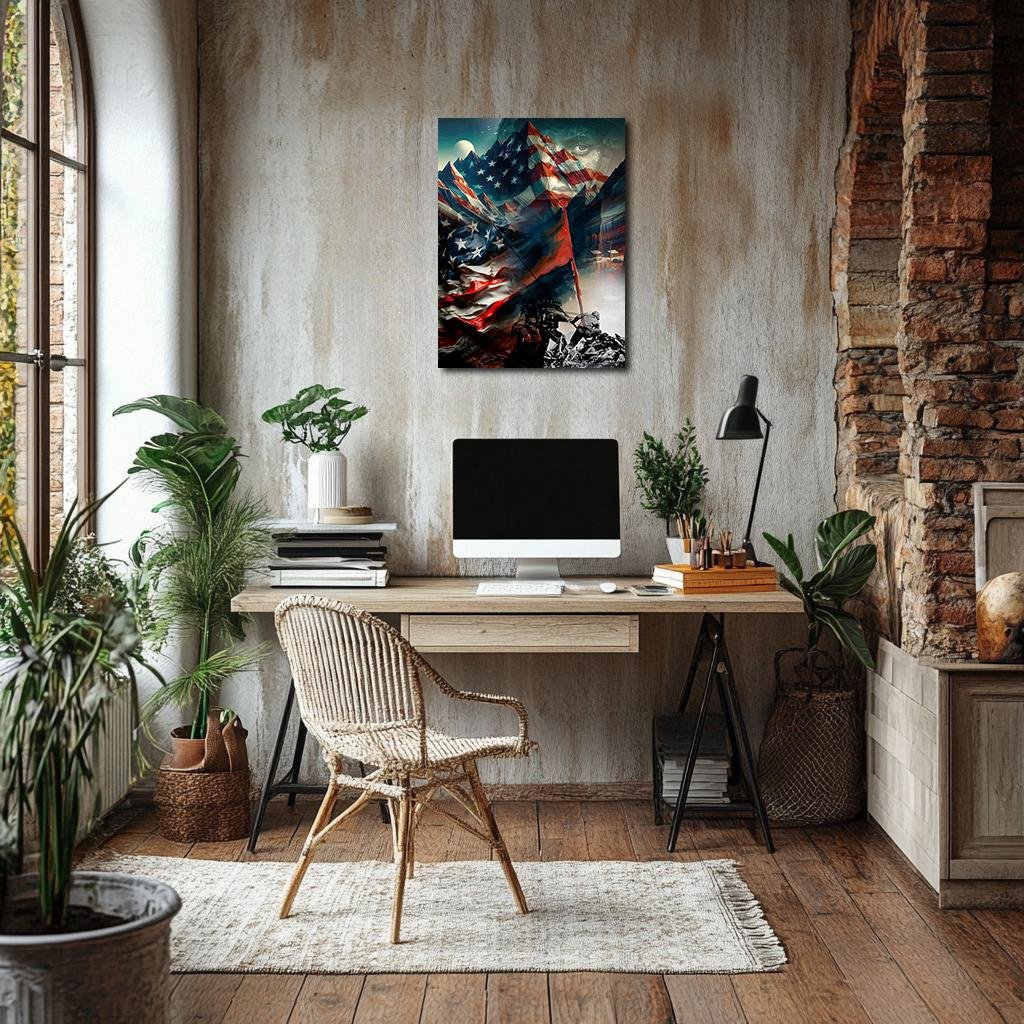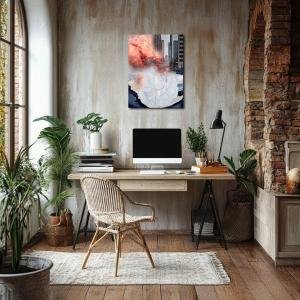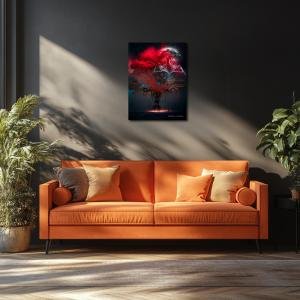Veins of a Nation: The Flag
Veins of a Nation reinterprets Georgia O’Keeffe’s The Flag as a complex portrait of national identity shaped by sacrifice, grief, and memory. Layering a soldier’s watchful face with surging flags, snow-touched mountains, and the historic Iwo Jima image, the work transforms the American flag into a living landscape—bleeding red, trembling white, and mourning in blue. The color palette channels emotion through shadowed crimson, deep navy, and ghostly white, mirroring the soul of a nation forged in war and remembrance. Here, patriotism is not pristine; it is raw, sacred, and eternally unfinished.
Please see Below for Details…
Hotline Order:
Mon - Fri: 07AM - 06PM
404-872-4663
Veins of a Nation reimagines Georgia O’Keeffe’s provocative and lesser-known painting The Flag through a digitally layered, emotionally heightened lens that evokes not only national identity but the deep psychological weight of collective memory, war, and sacrifice. O’Keeffe’s original—created in 1918 as a silent scream against the horrors of World War I—served as both elegy and protest. In this contemporary reconstruction, the flag is no longer still. It pulses, it bleeds, it climbs mountains and sinks into silence. The stars and stripes become sinews, binding together the disparate fragments of history, grief, valor, and unresolved conscience.
A towering face emerges behind the flag’s waves—a soldier, ghostly and alert, stares with hollowed eyes. His face is cracked with soot and sadness, a mirror of the internal fracture that war imposes on both those who serve and the country they fight for. Around him, the American flag spreads and folds across craggy peaks, symbolizing not just geographical vastness but the moral altitude and burden of a nation rising on sacrifice. The undulating stripes sweep across the scene like rivers of blood and hope, their movement tying the past to the present, the solemn to the celebrated.
In the lower portion of the image, the iconic photograph of the raising of the flag on Iwo Jima is woven into the flag’s fabric itself, becoming not a separate act but a continuation—a thread in the same tapestry of national identity. The soldiers strain, their bodies leaning with effort, not only to hoist a symbol but to uphold a legacy carved in pain. It’s a moment of pride, yes, but also of complexity, for what is patriotism without the price it extracts?
The background flutters between scenes of stark serenity and ominous quiet—a small-town America nestled under flags, streetlights burning in dusk shadows. This is the silent homefront, the place where the echo of every battle lives on. Snow-capped mountains form the upper reaches, their slopes rippling with the same red, white, and blue—a visual metaphor for how deeply the American identity has been etched into the land itself.
The color story of this piece is bold and bruised. The red in the flag is not simply decorative—it is blood, pulse, memory. It bleeds into the sky and the mountains like a wound that refuses to clot. Red here is both sacrifice and defiance, a reminder of every life torn to uphold the weight of freedom. The white is not pure—it is haunted. It flickers like frost, cold and ephemeral, a reflection of innocence lost and the shivering aftermath of grief. The stars, scattered in blue like bruises across the sky, represent both unity and mourning. This blue is deep—naval, almost black in places—symbolizing sorrow, service, and the soul of a nation constantly at war with itself.
Georgia O’Keeffe’s The Flag was created in response to the death of her friend, Charles, who died in the war shortly before the armistice. She painted it in silence, never publicly explaining it, and it was not exhibited until decades later. This reimagining builds on that silence—not to break it, but to echo it louder, through modern symbolism and digital storytelling. It’s a reinterpretation not as propaganda, but as a human reckoning.
The flag, in this vision, is no longer fabric. It becomes topography. It becomes memory. It becomes face, fire, burden. It flies not in triumph, but in truth. And in that truth lies the art’s aching power.
Add your review
Your email address will not be published. Required fields are marked *
Please login to write review!
Looks like there are no reviews yet.








